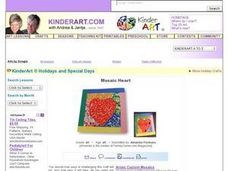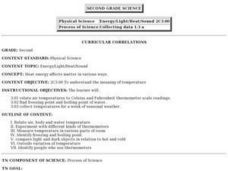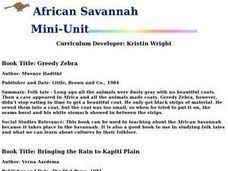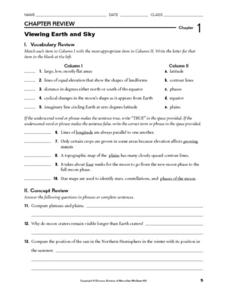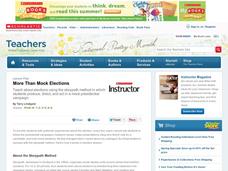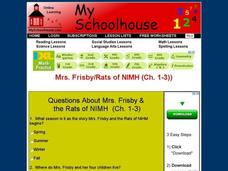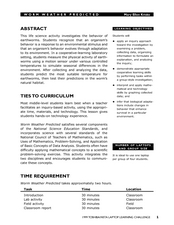Curated OER
Treetures
Students identify the different forests of the world and some of the characteristics that differentiate them. They explore old magazines, calendars and photos and fill out a scavenger hunt worksheet.
Curated OER
Flag Wars
High schoolers consider how zoning policy shapes the character of neigborhoods. They see how zoning and loan policies have been used historically in the U.S. to benefit some people and discriminate against others. They examine tensions...
Curated OER
Working Watermelon
You're going to wish you had a watermelon for this lesson! Class members read about watermelons and make a salad in class to sample. They also perform estimates, measurements and calculations on a watermelon. They predict what percentage...
Curated OER
Water/Agua
Third graders complete water activities including vocabulary, visualization and performing activities. They study water vocabulary words in both English and Spanish. They listen to a read aloud of Jane Yolen's, Letting Swift River Go,...
Curated OER
Mosaic Heart
Students create "Mosaic Hearts" in this adaptable art activity using some old magazines, construction paper, and glue. The activity includes examples of finished hearts and a materials list. Ideal for a Valentine's Day activity!
Curated OER
Objects in the Sky
Students explore what the sky looks like at different times. They identify objects in the sky and recognize changes over time. Students observe the sky and look for objects that are common in both the daytime and the nighttime sky.
Curated OER
Sky 4: The Moon
Students will draw the moon's shape for each evening on a calendar and then determine the pattern in the shapes over several weeks. Students' understandings should be confined to observations, descriptions, and finding patterns.
Curated OER
Building a DNA Molecule, Mitosis in Motion and Mutation Gossip
Students explore three lab experiments involving DNA, mitosis, and mutation. They complete activities and play games to review DNA, mitosis and mutation concepts. They build a DNA molecule and create flip cards representing mitosis in...
Curated OER
Heat Energy- Temperature
Second graders investigate the meaning of temperature. They determine what happens to a thermometer when the temperature rises or falls. They place thermometers in different classroom locations in order to compare the temperature in a...
Curated OER
African Savannah
Students are read two African fairy tales. Using the text, they create a map and key for each region mentioned. They compare and contrast the various communities and discover how geographic features affect how people live.
Curated OER
Following Sean Lesson Plan
Students view a film about two families living in San Francisco during the 1960s. They examine clips of the film and take notes on its historical context and discuss what historical information can be received from first-hand...
Curated OER
Exploring the Night Sky: Fall/Winter
Students explain how moon phases occur. They explain three ways that the night sky has been used through history. Students locate some of the constellations in the night sky. They discuss stories and myths surrounding stars.
Curated OER
Worship in Early Times
Students listen to and discuss three radio broadcasts that deal with worship in early times. They investigate a wide range of historical sources and piece together evidence of the past, Celtic beliefs and how early people worshiped...
Curated OER
Mahler
In this music worksheet, students read a short piece about Gustav Mahler, the composer. They write responses to 10 questions about this romantic composer. Students are asked to comment on Mahler's interests, techniques, and musical style.
Curated OER
Students Information And Interest Survey
In this personal information instructional activity, students fill out this form to give details about their personal history, prior experiences and preferences. This could be used for information gathering or as an icebreaker activity.
Curated OER
Viewing Earth and Sky
In this earth and sky worksheet, learners review terms associated with map reading. Students also review topographic maps and how contour lines represent elevation. This worksheet has 5 matching, 5 true or false, 5 fill in the blank, and...
Curated OER
Run-on Sentences, Comma Splices and Fragments
In this grammar worksheet, students identify twenty sentences as run-on sentences, fragments, has a comma splice mistake or as correct. Students defend their choices.
Curated OER
Conductors- Gustav Mahler
In this musical conductors worksheet, 9th graders read about Gustav Mahler, nineteenth European conductor. They use this information and further research to answer 10 questions about his life and accomplishments.
Curated OER
More Than Mock Elections
Middle schoolers create a presidential campaign story. In this presidential campaign lesson, students produce, direct and act in their own campaign story. Stories focus on setting, characters, context, critical incidents, and concluding...
Curated OER
Mrs. Frisby and the Rats of NIMH (Ch. 1-3)
For this online interactive Mrs. Frisby and the Rats of NIMH worksheet, learners respond to 14 multiple choice reading comprehension questions regarding chapters 1-3 of the book.
Curated OER
Worm Weather Predicted
Students examine worm habitats. In this animal habitats lesson, students participate in a lab activity that requires them to explore the adaptations that earthworms make to their environment.
Curated OER
Threatened, Endangered & Extinct Lesson Plan
Students examine the basic needs of living organisms. In this science lesson, students study ecosystems and discover that organisms have basic needs that must be met.
Curated OER
Water 1: Water and Ice
Students explore forms that water can take and examine the water cycle. In this hands-on science lesson, students participate in activities that require them to change water to a solid and back to a liquid again.
Curated OER
Water and Ice
Students explore water and ice. In this 3 states of matter lesson, students work with a partner to observe, illustrate, and describe the characteristics of an ice cube in a cup. The ice cube is observed again in 15 minutes and changes...




